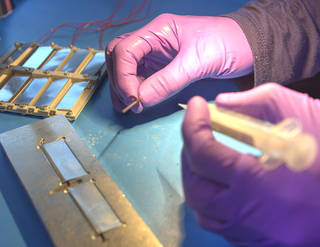An older technology once de rigueur for preventing spacecraft gadgetry from getting too hot or too cold has been resurrected and repurposed for an emerging class of small satellites now playing an increasingly larger role in space exploration, technology demonstration, and scientific research.
NASA Principal Investigator Allison Evans and her team at the Goddard Space Flight Center in Greenbelt, Maryland, have successfully miniaturized the thermal-control technology and now plan to flight test it on the maiden flight of the Goddard-developed Dellingr spacecraft, a new-fangled 6U CubeSat purposively created to easily accommodate NASA-class science investigations at a lower cost. The tiny Dellingr measures about 12 inches long and four inches high, and could launch later this year, developers said.
“CubeSats were traditionally used by the university research community,” said Evans, whose team also includes Goddard technologists Cindy Goode and Todd Bentley. “They ran on only a few watts of power, carried very small payloads, and had mission lifetimes of only a few hours to weeks in low-Earth orbit. However, this paradigm is changing.”
Given the relatively low cost and fast turn-around time of the CubeSat platform, NASA and others are adopting it for a range of exploration, technology-demonstration, and scientific missions of up to a few years. Some deployable solar panels designed specifically for this spacecraft class can provide 80 watts of peak power, enabling more power-intensive CubeSat missions
Overcoming Thermal-Control Challenges
The higher wattage has created challenges, however. How do mission designers regulate the temperature of the more power-hungry or temperature-sensitive flight instruments inside satellite buses that can be as small or smaller than a cereal box? Electronic thermal-control devices add weight and consume valuable space, making them less appropriate for small satellites, she said.
“One of the things I observed at the time was that no one had begun developing passive thermal-control technology for CubeSats,” Evans said.
She embraced the challenge, turning to a technology used initially in the 1960s — a large panel of louvers measuring a couple feet in diameter. Like venetian blinds, the louvered flaps would open or close depending on whether an instrument needed to shed or conserve heat. The new thermal-control louver technology operates in much the same way as its forebear. It, too, requires no electronics and is completely passive.
The device measures about four inches on a side and can be linked together to accommodate almost any small-satellite mission, whether it is a 3U CubeSat or something larger than even Dellingr. Each unit includes front and back plates, flaps, and springs. The back plate is painted with a white, highly emissive paint — boron nitride nano mesh (BNNM) — developed by Goddard materials expert Mark Hasegawa. The front plate and flaps are made of aluminum, which aren’t as emissive.
“The bimetallic springs do the heavy lifting,” Evans said. Measuring just a quarter-of-an-inch in diameter, the springs are made of two different types of metal. Attached to the highly emissive back plate, they uncurl if one of the metals gets too hot, forcing the flaps to open. When the spring cools down, it reverts back to its original shape and the flaps close.
Testing Proves Effectiveness
Since building the device, Evans and her team have put the unit through the paces to determine performance.
In a benchtop lifecycle test, the team ran more than 12,900 cycles exposing the device to temperatures of between 91 to 131 degrees Fahrenheit. The bimetallic springs experienced no failures, she said. The team also carried out eight thermal-vacuum test cycles at temperatures of between minus 4 degrees and 185 degrees Fahrenheit, finding that the technology dissipated an amount of thermal energy significant to a CubeSat. A vibration test also indicated the technology had achieved qualification levels.
The proof of its effectiveness, however, will come during the Dellingr mission, she said. During that technology demonstration involving a smaller experimental version, she is anticipating that the device will prove its effectiveness as a spaceflight technology.
Source: NASA

































Leave a Comment
You must be logged in to post a comment.